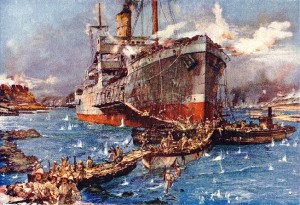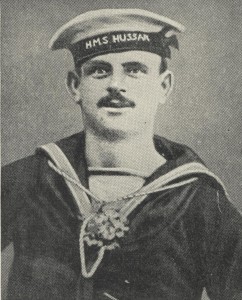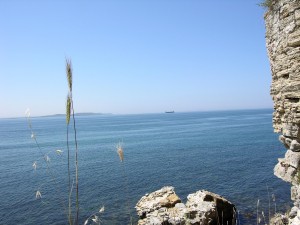Standing in the Footsteps of Valour
V Beach, Gallipoli and the SS River Clyde
The SS River Clyde was built in 1905 in Glasgow, Scotland as a 4,000 ton collier. Similar to the Trojan horse used at Troy, the River Clyde, on April 25, 1915, was used to transport troops onto V Beach, Cape Helles the southernmost point of the Gallipoli Peninsula. Holes were cut into the ship’s hull from which 2,000 troops of the 1st Royal Munster Fusiliers, 1st Dublin Fusiliers and the 2nd Hampshire Regiment disembarked, when the River Clyde was beached near the rocky outcrop shown in the above video. This outcrop can also be seen in the black and white image, also in the video, taken of V Beach from the River Clyde; the outcrop to the right and Sedd el Bahr (Fort No. 3) on the extreme right.
Prior to the beaching of the River Clyde troops were landed from other ship’s lighters that were either towed or rowed towards the shore. Once the River Clyde was beached, gangways from the ship allowed the troops to descend upon a bridge constructed across three lighters that led them to shore. Subjected to heavy enfilade fire the devastation on the beach was horrific. Several attempts were made to land the troops but it was not until dark that the last 1,000 men from the River Clyde were landed.
The River Clyde remained in this position throughout the campaign serving as a both a dock and breakwater and was an immediate target for Turkish gunners. The whole while equipment in the ship was used to make fresh drinking water and, within the hull, a field dressing station was established.
After the evacuation from Gallipoli, late December 1915 – January 9, 1916, the River Clyde remained beached for the duration of the Great War, but was refloated and taken to Malta where it underwent repairs. The vessel then had a long history serving across the Mediterranean and survived until 1966 when, despite efforts to save the ship, the River Clyde was broken up.
In all five awards of the Victoria Cross were granted to men of the SS River Clyde for their actions during the April 25, 1915 landings at V Beach. The recipients include Scottish born Seaman George McKenzie Samson.
SPECIAL RECOMMENDATIONS
Despatch of Vice Admiral John M. De Robeck
Supplement to the London Gazette, August 16, 1915, page 8129
Awards of the Victoria Cross announced page 8132
Commander Edward Unwin, R.N.
While in “River Clyde,” observing that the lighters which were to form the bridge to the shore had broken adrift, Commander Unwin left the ship and under a murderous fire attempted to get the lighters into position. He worked on until, suffering from the effects of cold and immersion, he was obliged to return to the ship, where he was wrapped up in blankets. Having in some degree recovered, he returned to his work against the doctor’s order and completed it. He was later again attended by the doctor for three abrasions caused by bullets, after which he once more left the ship, this time in a lifeboat, to save some wounded men who were lying in shallow water near the beach. He continued at this heroic labour under continuous fire, until forced to stop through pure physical exhaustion.
Midshipman George L. Drewry, R.N.R.
Assisted Commander Unwin at the work of securing the lighters under heavy rifle and maxim fire. He was wounded in the head, but continued his work and twice subsequently attempted to swim from lighter to lighter with a line.
Midshipman Wilfred St. A. Malleson, R.N.
Also assisted Commander Unwin, and after Midshipman Drewry had failed from exhaustion to get a line from lighter to lighter, he swam with it himself and succeeded. The line subsequently broke, and he afterwards made two further but unsuccessful attempts at his self-imposed task.
Able Seaman William Chas. Williams, O.N. 186774 (R.F.R. B.3766).
Held on to a line in the water for over an hour under heavy fire, until killed.
Seaman R.N.R. George McKenzie Samson, O.N. 2408A.
Worked on a lighter all day under fire, attending wounded and getting out lines; he was eventually dangerously wounded by maxim fire.
Seaman George McKenzie Samson was born at Carnoustie, Angus, Scotland in 1889. Having suffered several wounds during the action for which he was awarded the Victoria Cross, when back at home recuperating from these injuries he was presented with a white feather (a symbol of cowardice), when in civilian dress, by a group of unknowing individuals. On the other hand, for those who knew, those who were there to witness the actions of G.M. Sansom V.C., the surgeon aboard the SS River Clyde, Dr. P. Burrowes-Kelly, awarded the Distinguished Service Order for the action, remarked “He was in great agony when I saw him, and whether he lived or died I knew he had won the V.C.”
Did you know?
A sixth Victoria Cross granted for the landings at V Beach, though not a member of the SS River Clyde, was awarded to Arthur Waldene St. Clair Tisdall of the Anson Battalion, Royal Naval Division. Malia, Perring and Parkinson, recorded in the citation, were awarded Conspicuous Gallantry Medals.
London Gazette, March 31, 1916, pages 3515-3516
During the landing from the S.S. ” River Clyde ” at V Beach in the Gallipoli Peninsula on the 25th April, 1915, Sub-Lieutenant Tisdall, hearing wounded men on the beach calling for assistance, jumped into the water and, pushing a boat in front of him, went to their rescue. He was, however, obliged to obtain help, and took with him on two trips Leading Seaman Malia and on other trips Chief Petty Officer Perring and Leading Seamen Curtiss and Parkinson. In all Sub-Lieutenant Tisdall made four or five trips between the ship and the shore, and was thus responsible for rescuing several wounded men under heavy and accurate fire.
Owing to the fact that Sub-Lieutenant Tisdall and the platoon under his orders were on detached service at the time, and that this Officer was killed in action on the 6th May, it has only now been possible to obtain complete information as to the individuals who took part in this gallant act. Of these, Leading Seaman Fred Curtiss, O.N. Dev. 1899 has been missing since the 4th June, 1915.
V Beach was not the only site of Victoria Cross actions on April 25, 1915. Six awards were granted to soldiers of the 1st Lancashire Fusiliers who landed on W Beach, of which the phrase, “Six VCs before breakfast” has become legend.
The 1st King’s Own Scottish Borderers landed at Cape Helles on Y Beach with the Plymouth Battalion, Royal Marine Brigade, Royal Naval Division on April 25, 1915. Although initially unchecked, the Turkish counter-attack commencing at dusk led to heavy casualties and the force evacuated April 26, 1915.
On April 26 1915 actions at or near the fort and village of Sedd el Bahr, resulted in the award of three Victoria Crosses to Corporal William Cosgrove (1st Royal Munster Fusiliers) and posthumously to Captain Gareth Neville Walford (Royal Artillery) and Lieutenant Colonel Charles Hotham Montagu Doughty-Wyllie (Royal Welch Fusiliers). Doughty-Wyllie’s grandfather, David Cameron, was the first Chief Justice of the colony of Vancouver Island, 1853 – 1865.
The Gallipoli Peninsula is silent now but the valour continues to echo. Standing in these footsteps, these places of tumult, allows the visitor to immerse themselves in these days and nights long past. As we follow the trail across the beach and onto the rocks, or climb amongst the ruins of Sedd el Bahr I watch the horizon – observing distant ships entering peacefully into the Dardanelles headed towards the Sea of Marmara and the Black Sea.




Hi the picture of the ships i had in my parents home, the main picture is in chestow church, ours whent to chestow museum, still there plus or info large medal cut from the ship, river plate plus more pictures, the V C was sold by my dads brother, when my dad found out he was not very happy,